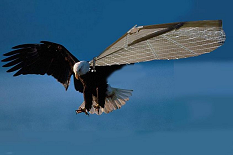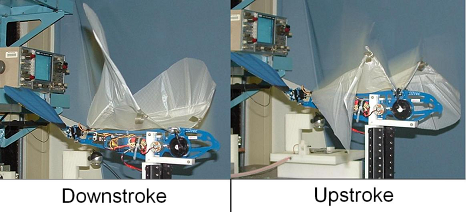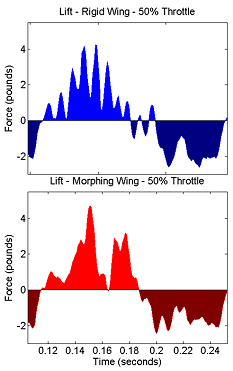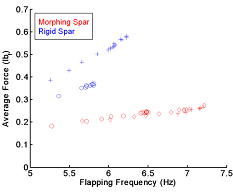![]() Passive Wing Morphing
Passive Wing Morphing
Executive Summary
 Ornithopters, like birds, flap their wings to generate both thrust and static lift. The thrust, in turn, propels the ornithopter forward so that the velocity of the air moving past the wings introduces dynamic lift. When the combined forces of static and dynamic lift are sufficient to overcome gravity, flight is sustainable.
Ornithopters, like birds, flap their wings to generate both thrust and static lift. The thrust, in turn, propels the ornithopter forward so that the velocity of the air moving past the wings introduces dynamic lift. When the combined forces of static and dynamic lift are sufficient to overcome gravity, flight is sustainable.
Left: Passive Wing Morphing Concept
This research set off to investigate a method to increase the average static lift of the ornithopter. Current ornithopter designs mechanically drive a pair of wings up and down, but on average, do not produce as much static lift as their biological counter parts. In low speed flight regimes, ornithopters plummet to the ground while birds can hover and perch. Increasing available static lift could make this maneuverability available in flapping wing ornithopters.
The principle flaw of wing flapping is the cyclic way in which the upstroke of the wing undoes the success of the previous downstroke. Negative lift cancels out positive lift almost completely in existing designs.
By allowing the wings to mechanically morph during flight, several ornithopters repeatedly generated approximately 400% as much average static lift as non-morphing wing designs. Unfortunately, this flapping mode took a penalty on the available thrust of the ornithopter, reducing its dynamic lift.
Primary Project Objectives
- Created a repeatable construction method for the creation of passively morphing wings, flexing at a discrete wing joint location
- Performed static tests to measure lift and thrust in a stationary ornithopter
- Analyzed the data with Fourier techniques to determine the correlation of flapping frequency and average static force
- Flight tested designs to confirm results
Research Description
Ornithopters produce static lift by flapping their wings and dynamic lift by moving through the air, powered by the thrust generated during each flapping cycle. This research project was designed to explore a method of increasing the static lifting force available while the ornithopter was flapping.

Full Wing Area on Downstroke; Reduced Area on Upstroke
The ornithopters tested in this research project flew best when flapping at around 7 Hz. At these speeds, the wings displayed impressive deflections in the wing spars and powerful curves in the sail area. This change in the wings helps generate thrust. By extension a different change in shape might also increase static thrust.
 A mechanical spring joint was fabricated to be placed along the main spar of each wing, along the leading edge. This joint was restricted in motion along the top so that the spar would be stiff on downstrokes. On each upstroke, the springs were permitted to deflect, dramatically reducing the area of each wing and thus reducing the negative lift of this portion of the flapping cycle. About the time that each wing reached the top of its stroke, the pair of springs would restore the wings back to their original configuration, ready for the next downward stroke.
A mechanical spring joint was fabricated to be placed along the main spar of each wing, along the leading edge. This joint was restricted in motion along the top so that the spar would be stiff on downstrokes. On each upstroke, the springs were permitted to deflect, dramatically reducing the area of each wing and thus reducing the negative lift of this portion of the flapping cycle. About the time that each wing reached the top of its stroke, the pair of springs would restore the wings back to their original configuration, ready for the next downward stroke.
Load cell measurements were collected for each ornithopter design over varied frequencies. However, these frequencies were unknown. By applying Fourier transforms of each test result, data could be divided into an integer number of complete flapping cycles. Within each flapping cycle, the ornithopters exhibited a region of positive static lift and of negative static lift. This approach enabled the rapid comparison of several different ornithopter designs over a whole array of flapping frequencies. Results for average static lift and average static thrust are in the charts below.
 This plot is a comparison of four differently constructed ornithopter wing sets with the same wing shape and area. Each wing pair was mounted on the same ornithopter, strapped to a load cell. The throttle on the bird was increased to induce an increasing flapping frequency. Naturally, the higher flapping frequencies corresponded to larger static lift readings. These readings were averaged out over an integer number of complete flapping cycles to yield the average static force. The two blue data sets represent the original method of wing construction with rigid, non-morphing spars. The two red data sets describe the force produced with morphing wings.
This plot is a comparison of four differently constructed ornithopter wing sets with the same wing shape and area. Each wing pair was mounted on the same ornithopter, strapped to a load cell. The throttle on the bird was increased to induce an increasing flapping frequency. Naturally, the higher flapping frequencies corresponded to larger static lift readings. These readings were averaged out over an integer number of complete flapping cycles to yield the average static force. The two blue data sets represent the original method of wing construction with rigid, non-morphing spars. The two red data sets describe the force produced with morphing wings.
Average static lift, the force responsible for hovering and perching in bird flight maneuverability, was increased to approximately 400% by passively morphing the wings.
 With great success in available static lift, there was an unfortunate drawback: the ornithopters produced far less thrust in the passively morphing wing designs. Flight tests highlighted this behavior. Load cell tests for average static thrust indicated that the morphing spars indeed had this penalty. Five construction models were tested for thrust performance in the flapping wings. The non-morphing wings performed better.
With great success in available static lift, there was an unfortunate drawback: the ornithopters produced far less thrust in the passively morphing wing designs. Flight tests highlighted this behavior. Load cell tests for average static thrust indicated that the morphing spars indeed had this penalty. Five construction models were tested for thrust performance in the flapping wings. The non-morphing wings performed better.
It has been speculated that results could be improved by at least two methods. The first is to purposefully direct the wing tip motion of ornithopters to mimic biological shapes displayed in nature. The second is to actively morph the structure of the wings during flight.
The results were submitted to the 2007 AIAA Regional Student Conference for the (I-MA) Mid-Atlantic Region in the form of a technical paper and a presentation. On merit of the accessibility of the presentation and the original approach of the author, the research project in Passive Wing Morphing was awarded third place.
![]()

